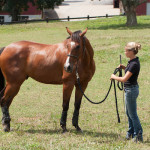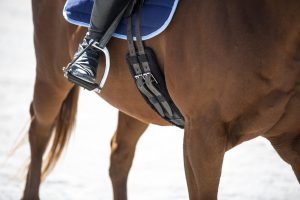Walk into any tack store and you will find a dozen gadgets to “fix” your riding problems. Or browse the internet and you will find offers of “3-day colt starting” or books that promise to fix your horse problems in just a few easy steps.
So many horses today are trained very quickly and then resold or handed back to the owners. People fail to realize that one or two months on a young horse can be a great start but is hardly enough to suddenly call him beginner safe or anything like that. In the same way, if a horse has several years of bad riding and all those bad experiences in his head, a month at the trainers to fix a problem does not mean he is a changed horse. Old triggers can still bring that problem back. We as horse owners need to work on ourselves every bit as much as we work on our horses. Every time we interact with our horses we are teaching them something whether we like it or not.
Don’t get me wrong – most of the horses I get in are for 30 days training, but I like to keep the owners very involved through the training process, so they can continue the work with their horse at home.
And to the main point of this article – slow is fast. Taking the time to train your horse the right way, taking one step at a time, building a foundation for the horse mentally and physically, and being careful to challenge your horse but not so much that you scare or injure him is so important! When a horse is brought along correctly, you don’t have to go back and redo everything later and you don’t have to “just deal” with bad habits every time you ride. This is why “slow is fast”. Starting out slowly, taking your time and doing things correctly will save you time in the long run because once you have that good foundation on your horse other training will progress much quicker than you expect!
There are a ton of examples for this, take starting a young horse, if you go too fast and get bucked off not only did you just scare your horse, but now he knows that bucking is a very effective way to launch you. It’s going to take a lot longer to undo this then if it never happened. Next, take training a jumper, if you start raising the jumps too fast on an inexperienced horse he is going to get scared because he does not have the confidence to know where to put his feet if the approach is less than perfect. Eventually you will have a refusal or runout. Again, what has this horse just been taught? How about using a big leverage bit to get your horse to collect – you might get some collection in the first ride but it’s not true relaxed, working from the hind end collection, it’s probably stiff and bracy because the horse is just trying to avoid the pain caused by the bridle. I could go on and on with examples, but I am sure everyone else is thinking of them too!
The moral of my story here is go slow with your horse, take the time to do it right the first time and you won’t have to redo it later!
Does anyone have thoughts to add to this? Do you agree or disagree with the slow approach? Let us know in the comments!














3 Responses
Hi Callie,
3 months ago I adopted a 6 year QH mare from a horse rescue where I have enjoyed some volunteering time. As you can imagine, horsey folks have varied opinions about rescue horses, and here in Alberta where I live, sadly, the slaughterhouse industry is a big commodity and many unwanted horses lives’ end there.
As you have outlined in your Training Ideas blogs about the ineffectiveness of harsh dominance and rushing training along I have taken things very slowly with my new horse. She was halter broken and was good with her feet being handled, but that was it. So far, we have spent all our time together developing our friendship and trust through lots of grooming, going for walks, and doing some groundwork (learning moving over, backing up, turning, circling, and some gentle flexing of the head from her halter.) It has been so enjoyable and she has shown herself to be very happy and enthusiastic with this approach. It takes endless patience especially to stay calm and “try again” until there’s understanding – but in the end it’s so worth it.
I’ve heard, “you should get a bridle on her” (to proceed further), but again, I am in no hurry to do that as she is responding just fine with the halter, and because of that, I plan to start her in a Dr Cook’s Bitless Bridle (which I have researched and is the only form of bitless I would consider). Again, you mention going bitless, and you get all kinds of opinions about it, but as I have no plans beyond pleasure riding (I value my life, more so than ever now that we are grandparents and nearing retirement!) and if it proves successful for my horse, then we’ll both be happy when we do eventually move on to riding.
Thank you so much for loving horses and being so passionate about their good care and training and sharing what you have learned as a horse owner, trainer, and instructor. I am so happy I found CRK Training!
My daughter and I had the privilege of working with a young gelding that previously had been started under saddle 3 times without success and once with a cart which ended even more disastrously
The owners essentially just didn’t have the patience or the interest to work out a training plan that worked
It took two years to unpick the negative experiences and then take him forward… He is back with his owner now and working really well… I love it when the Facebook memories pop up to remind me of his journey from being completely stressed and with severe separation anxiety to a very Chilled and willing…. It was a lovely two years ❤️
Great example of working on things slowly to benefit in the long run Tracy!
-Julia, HorseClass Community Manager